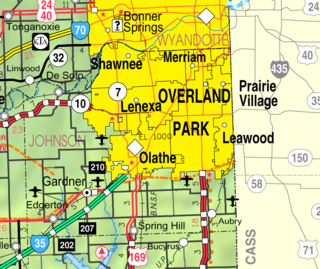
Leon is a city in Butler County, Kansas, United States. As of the 2020 census, the population of the city was 669.

McCune is a city in Crawford County, Kansas, United States. As of the 2020 census, the population of the city was 370.

Mulberry is a city in Crawford County, Kansas, United States. As of the 2020 census, the population of the city was 409.

Jennings is a city in Decatur County, Kansas, United States. As of the 2020 census, the population of the city was 81.

Gove City, more commonly known as Gove, is a city in and the county seat of Gove County, Kansas, United States. As of the 2020 census, the population of the city was 80.

Merriam is a city in Johnson County, Kansas, United States, and part of the Kansas City Metropolitan Area. As of the 2020 census, the population of the city was 11,098. Merriam is included in the Shawnee Mission postal designation. It is also the headquarters of Seaboard Corporation.

Kingman is a city in and the county seat of Kingman County, Kansas, United States. As of the 2020 census, the population of the city was 3,105.

Meade is a city in and the county seat of Meade County, Kansas, United States. As of the 2020 census, the population of the city was 1,505.

Ness City is a city in and the county seat of Ness County, Kansas, United States. As of the 2020 census, the population of the city was 1,329. Ness City is famous for its four-story Old Ness County Bank Building located downtown and nicknamed Skyscraper of the Plains.

Lyndon is a city in and the county seat of Osage County, Kansas, United States. As of the 2020 census, the population of the city was 1,037.

Alton is a city in Osborne County, Kansas, United States. As of the 2020 census, the population of the city was 100.

Minneapolis is a city in and the county seat of Ottawa County, Kansas, United States. As of the 2020 census, the population of the city was 1,946.

Belleville is a city in and the county seat of Republic County, Kansas, United States. As of the 2020 census, the population of the city was 2,007.

Palco is a city in Rooks County, Kansas, United States. As of the 2020 census, the population of the city was 208.

Bunker Hill is a city in Russell County, Kansas, United States. As of the 2020 census, the population of the city was 103.

Dorrance is a city in Russell County, Kansas, United States. As of the 2020 census, the population of the city was 146.

Luray is a city in Russell County, Kansas, United States. As of the 2020 census, the population of the city was 166.

Andale is a city in Sedgwick County, Kansas, United States. As of the 2020 census, the population of the city was 941.

Mount Hope is a city in Sedgwick County, Kansas, United States. As of the 2020 census, the population of the city was 806.

Alma is a city in and the county seat of Wabaunsee County, Kansas, United States. As of the 2020 census, the population of the city was 802.


















